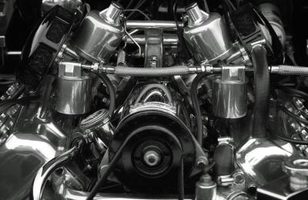Knock sensors and oxygen sensors, or O2 sensors, function as sensing devices that detect variations in an automotive engine’s performance. Knock sensors monitor the combustion cycle of the engine, determining if the fuel is burning cleanly and efficiently, or burning too soon, by "listening" or detecting audible knock vibrations during cylinder firing. Oxygen sensors, which are mounted in the exhaust system, detect unburned oxygen levels in the emissions gases after combustion. Both devices relay information to the ECM, or engine control module, to adjust fuel delivery to the cylinders or modify the ignition timing. Basic differences exist between the function of knock and oxygen sensors.
Knock Sensor Construction and Location
-
A knock sensor is a small cap or plug-like component that usually has a threaded end that screws into the engine block near the cylinder or valve locations, and often is placed at the rear of the engine. A knock sensor incorporates a small piezo crystal and shunt resistor inside its case, designed to pick up minute or heavy knock vibrations in the cylinder or cylinders. This information is relayed to the ECM through wires connected to the sensor.
Knock Sensor Theory and Operation
-
Knocking or pinging during engine operation is the result of pre-ignition. Pre-ignition happens if the fuel has the wrong octane level, incorrect timing, uneven fuel burning and, in some cases, can be caused by hot spots inside the cylinder. The small microphone-type sensing element inside the knock sensor reads any abnormal fuel-burning characteristic through vibration, and sends an electric signal to the ECM. The ECM reacts by decreasing the ignition timing in small increments, usually two degrees at a time, until the vibrations or knocks are decreased and eliminated. The vibration signals can be inaudible to the human ear, making knock sensors highly sensitive.
Oxygen Sensor Construction and Location
-
An oxygen sensor is a small tube-like component that screws into the exhaust manifold or header pipe in front of the catalytic converter. Some vehicles can have multiple oxygen sensors — as many as four– located in front of the catalytic converter and some placed behind it in the exhaust pipe. The sensor has a zirconium dioxide sensing element, heater contact, heater element and cable connector with wires that lead to the ECM. The oxygen sensor is sealed against moisture and contamination inside a solid shell-like casing.
Oxygen Sensor Theory and Operation
-
The oxygen sensor detects the amount of unburned oxygen after the combustion gases have left the cylinders. An overly rich air-fuel mixture contains less oxygen, while too lean an air-fuel mixture has more oxygen. The sensor sends this information to the ECM, which adjusts the air-fuel ratio through the vehicle’s fuel-injection system to promote smoother and more even cylinder firing, as well as cleaner emissions for peak catalytic converter performance. Since the oxygen level reading can depend on barometric pressure, air temperature, coolant temperature, engine load and air flow, the adjustments from the ECM are in constant fluctuation to compensate, flip-flopping from leaner to richer, or richer to leaner conditions.
Sensor Differences and Failure
-
The knock sensor uses a small listening device to detect vibrations in cylinder firing, and sends the information to the ECM, which initiates small ignition timing adjustments. On the other hand, the oxygen sensor relays information based on the ratio of the fuel to air being delivered into the cylinders via a sensing element. Faulty knock sensors can allow increased pre-ignition noises, misfires, backfires, and rough or jerky acceleration. Faulty oxygen sensors can allow a fixed rich fuel mixture, resulting in poor gas mileage, excessive harmful emissions and structural failure to the catalytic converter. Overly rich fuel conditions can cause a vehicle to fail a smog test, and show a diagnostic trouble code on the dash.
